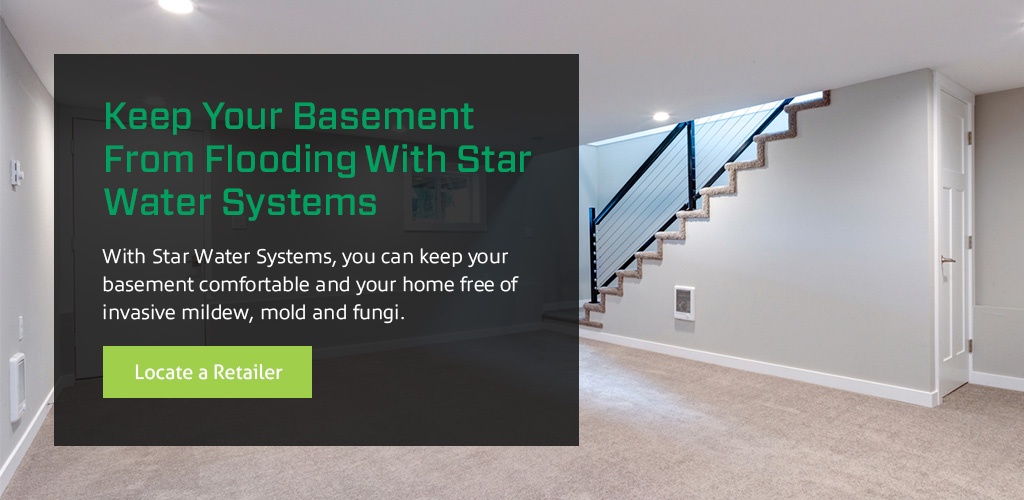Tips for Keeping Water Out of Your Basement
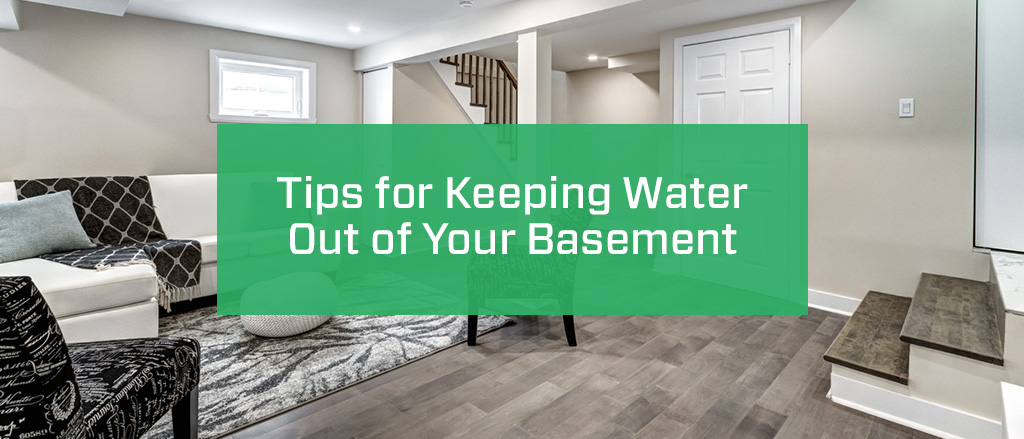
No one wants to walk down into their basement and discover water. Flooding is especially inconvenient if your basement is fully furnished. Water can soak into carpets, wood and furniture, causing mold and unpleasant smells. Keeping water out of your basement is essential if you want to avoid mold, damage and the need for repairs.
Basement water problems can seemingly come from nowhere. Understanding where water comes from and how to spot it can help you prevent flooding. If you want to know how to avoid basement flooding, you’ll need to know how water works and what lets it in. Once you know where to look, you can take action and keep your basement dry and safe year after year.
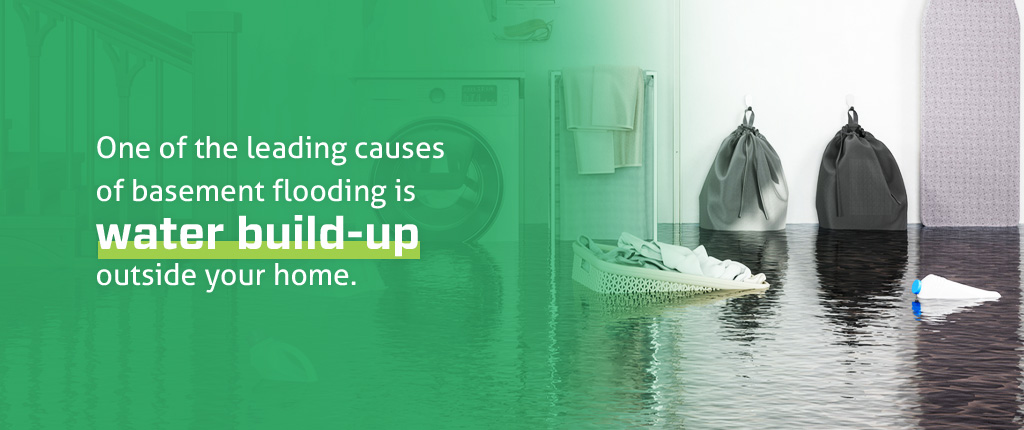
What Causes Basement Water Problems?
One of the leading causes of basement flooding is water build-up outside your home. As water collects, it begins to put pressure on the surrounding area, looking for somewhere to go. Over time, collected water can sneak inside and begin flooding your basement. Any cracks, old gutters or poor water-prevention measures can fail over time, allowing water to sneak inside and damage your space.
The biggest causes of basement flooding are runoff, subsurface runoff and condensation. Most water issues you see will be solved by addressing one of these areas. However, they can be broken down into smaller groups to help you understand how water tries to enter your home. Some potential causes of basement flooding include:
- Soil expansion: Clay-heavy soil might take on lots of water, causing the ground to expand and push against your structure. The wet soil pushing against your home will eventually squeeze water through gaps and cracks, forcing water inside.
- Runoff: Melted snow and rain might not seem like a big deal initially, but they are some of the leading causes of basement water damage. When not properly redirected away, runoff water will collect against your foundation and make its way inside. As it soaks into the soil around your foundation, hydrostatic pressure will eventually help it penetrate your home. You need to redirect runoff to make sure it does not sit against your home and eventually get inside.
- Frost: Frozen soil can lead to frost-heaving. Frozen soil can expand, causing water to push inside your basement. Additionally, soil can rise with freezing and fall with the thaw. The freeze-thaw process can also put too much pressure on your home and force water in.
- Hydrostatic pressure: Soil naturally absorbs water. When the soil absorbs all the water it can, the excess water must go somewhere. Without proper drainage, the excess water from soil will push against your home and collect around your basement exterior. The water will eventually push so much that it will find small cracks and gaps to enter through. Water escapes through these gaps as pressure pushes it out, flooding your basement.
- Failed vapor barrier: An incorrectly installed liner can lead to a vapor barrier failure. Vapor barriers are meant to keep water out, but they only work when installed properly. If you notice moisture coming into your basement and you have a vapor barrier, it might have been installed incorrectly.
- Condensation: Condensation looks like little water droplets, so it’s easy to confuse it with runoff. You’ll get condensation when warm air contacts cool or uninsulated pipes and walls. Condensation is unwanted moisture in a basement — over time, it can lead to mold, dampness, rot, rust and even insects. These issues will make your basement uncomfortable, eventually leading to expensive repairs.
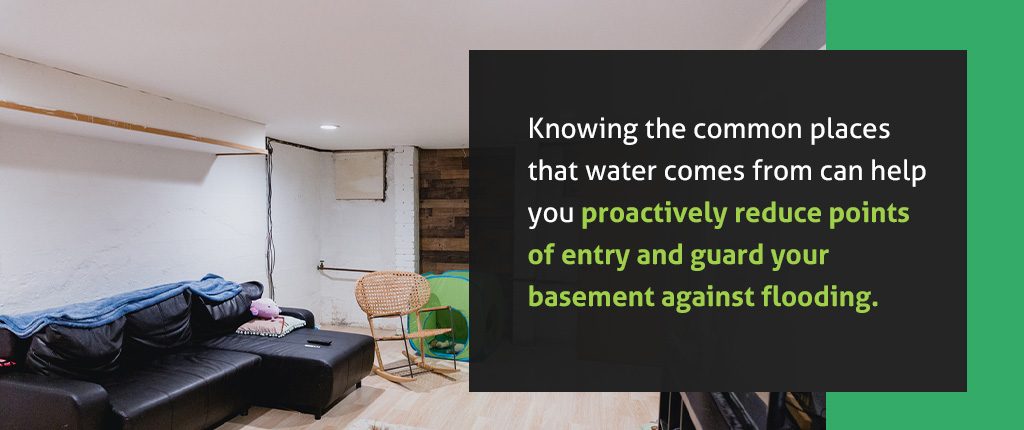
Where Does Basement Water Come From?
Water doesn’t just appear out of nowhere in your basement — it has to come inside from somewhere. Water is excellent at finding weak points and sneaking inside spaces. Knowing the common places that water comes from can help you proactively reduce points of entry and guard your basement against flooding.
Examine your basement thoroughly and try to spot any of the following water entry points you might have:
- Openings: Gaps around pipes, overlooked cracks, poorly sealed windows — any open spaces can allow water and insects to get in. Whether water pressure forces water inside or your vapor barrier fails, if there are weak spots and gaps, water will find a way inside. Cracks you might not easily see are perfect entry points for water, which can quickly move through your walls into the basement.
- Honeycombing: Honeycombing occurs when parts of your poured wall or concrete begin deteriorating and water flows through the crumbling sections. Deterioration often leaves openings for water to come in. You’ll most often see honeycombing around beams, columns, footings, slabs and walls.
- Top seepage: The space where your basement meets the above floor is a common entry point for water. Whether the materials are different or the soil drains water directly against that section, it’s a space where water likes to come through. You might see dripping water or a slight shine as the water travels down the basement wall from above.
- Cove joints: Cove joints are the spaces between basement walls and floors. Without proper drainage, water can begin to find its way in and start to collect in the cove joints. A proper drain-tile system can help drain water away before it seeps through your cove joints and settles in your basement.
- Pipes: Pipe installation involves drilling a larger hole, fitting the pipe in place and sealing the excess space with hydraulic cement. However, that hydraulic cement can break down over time. With too much deterioration, water will fill the empty spaces and sneak in next to your pipes, running down your basement walls and collecting on your floor.
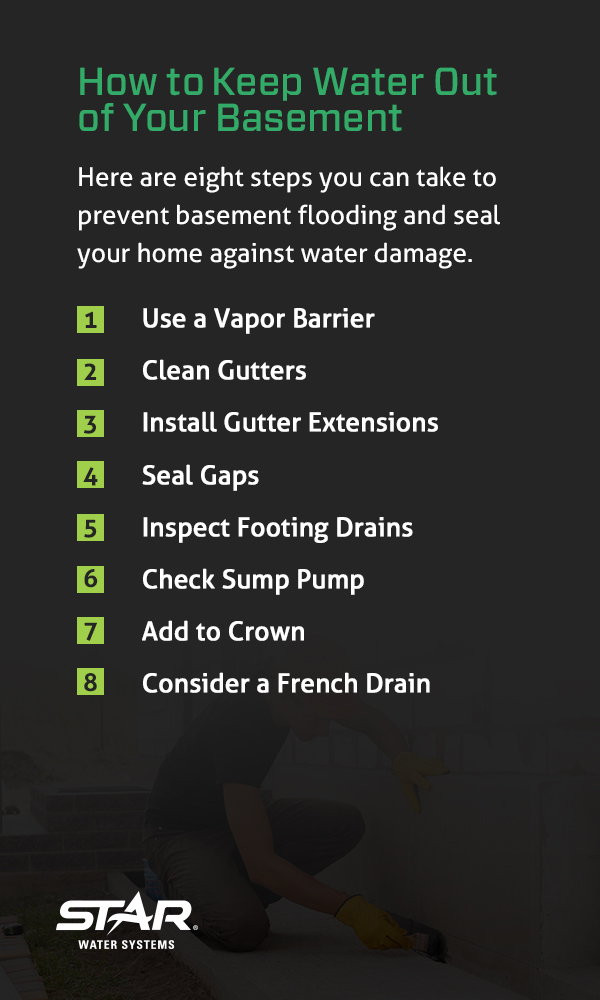
How to Keep Water Out of Your Basement
Now that you know how water gets in and what conditions can force water into your basement, you’re better prepared to take action against flooding. Understanding where water comes from is only half the battle — once you know the weak points, you need to strengthen them. With a thorough examination and taking a few steps, you can effectively seal your basement against water and keep your basement dry year-round.
You can implement a few of these strategies to prevent water entry. While some may be already in place, covering all your bases is essential for keeping water out. Consider consulting with a professional or basement water removal experts to help you find and correct all your water issues.
Here are eight steps you can take to prevent basement flooding and seal your home against water damage.
1. Use a Vapor Barrier
Vapor barriers or vapor retarders are polyethylene sheets installed over your basement walls to prevent water seepage and condensation. Moisture has difficulty traveling through the barrier, keeping it out of your basement. A well-installed vapor barrier will help keep your basement dry if you’re dealing with some moisture intrusion. Use them with other methods like gutter extensions and gap sealing to keep water out and away effectively.
2. Clean Gutters
Your gutters are integral for redirecting water away from your house. If they aren’t clean, they can’t redirect water. Clogged gutters cause water backups, allowing flooding to occur as water pools around the blockages. If gutters are blocked, they might not divert water far enough away from your home. Water that isn’t redirected away will fall back into the soil around your home’s foundation. Eventually, too much will lead to water pushing back against your home and seeping inside.
Make sure to regularly clean your gutters so they can work properly. With clean gutters, water can flow freely through the system and away from your home. When water is given a clear path to follow, it will travel along your gutters and run away from the house. If water isn’t settling around your home, it won’t pool and enter your basement.
3. Install Gutter Extensions
Keeping your gutters clean might not be enough. While clean gutters are essential for moving water, if your gutters aren’t long enough, water won’t be properly redirected away from your house. Short or improperly installed gutters can end too soon. As a result, water can collect next to the house, sink into the soil and eventually penetrate the basement.
Gutters must be long enough to redirect the water away from your foundation. You can install gutter extensions to extend several feet from the basement, redirecting water far away from your home. With a proper yard slope and gutter directions, diverted water is less likely to collect in the soil around your foundation and get inside.
4. Seal Gaps
Gaps, cracks and openings are the key to basement water flooding. If there are no openings to let water in, it will be much harder for your basement to flood. Use polyurethane caulk and hydraulic cement to seal gaps in walls, around pipes and near the windows. Look for any points where water is coming in or gaps you think it could come through and close them off.
If you’ve sealed every gap you can find and still have water coming up, it might be an issue with the groundwater. Look for water coming up from the floor itself or the area between the wall and the floor. If you have this issue, plugging gaps won’t help — groundwater is coming in, and you’ll need to check your footing drains.
5. Inspect Footing Drains
Many homes have footing drains, which lead to underground pipes around your foundation and help carry water away from your home. If you have a cleanout pipe that sticks out slightly, a drain or a maintenance hole cover in your basement floor, you’ve probably got footing drains. You’ll need to open the cleanout and use a hose to clear the pipes with water. Once the pipes are unclogged, the system will function correctly.
Additionally, you might have another issue with your basement drainage. Contact a professional for an inspection to help find the problem’s source.
6. Check Sump Pump
If you have a sump pump installed and you’re still dealing with basement water, you might need sump pump troubleshooting to get it working again. Sump pumps are an effective water removal system that helps prevent flooding. You can often repair your sump pump and quickly restore its functions, although it might be too old or broken for repairs. If you’ve had your sump pump for a while or it isn’t responding to repair, it might be time for a replacement sump pump in your basement.
Homeowners without a sump pump who are experiencing flooding issues might consider investing in one. Sump pumps help remove water that collects in the sump pit, draining it away before it gets into your basement or foundation. If you’re in an area that experiences heavy flooding, a sump pump can save you lots of time, money and stress.
7. Add to Crown
After plugging everything and checking your drainage, water still might creep in from the top of the foundation. You might need to restore your home’s soil crown to help with proper water redirection and drainage. The crown is roughly half a foot of soil that slopes away from your house on all sides. A slope like this helps water drain away from your home instead of settling against the foundation.
Soil settles with time. Water, wind and more all help erode and pack the crown, decreasing the slope and impacting water drainage. Use a water-shedding mix to build the crown back up. With a couple feet of soil, your crown will be restored and water will drain away from your home again.
8. Consider a French Drain
French drains are an exterior drainage system that helps relieve hydrostatic pressure and keep your basement moisture-free. Investing in a French drain can be pricey, but it’s worth it if you’re constantly dealing with expensive water issues. The ground around your home is excavated, and a perforated pipe is put in along your perimeter walls. The pipe runs away from your home — once it’s covered with soil again, the perforated pipe absorbs water and redirects it away from the foundation. It’s a worthwhile investment if you’ve been dealing with chronic basement flooding.
Keep Your Basement From Flooding With Star Water Systems
No one enjoys dealing with water damage. Investing in quality water removal systems and prevention will help protect your home and save you lots of money and headaches. With Star Water Systems, you can keep your basement comfortable and your home free of invasive mildew, mold and fungi. Dependable water systems prevent basement flooding and help save you money in the long run — the better your system, the longer it will last and the more money you’ll save on repairs.
Whether you need help with basement water removal or you’re looking to invest in utility pumps, pool pumps, sewage pumps, well pumps and more, we’ve got you covered. Our basement water removal options offer durable, long-lasting solutions for your home. Contact us to learn more about Star Water Systems or get started by finding a retailer near you.
 Buy Now at Lowes
Buy Now at Lowes